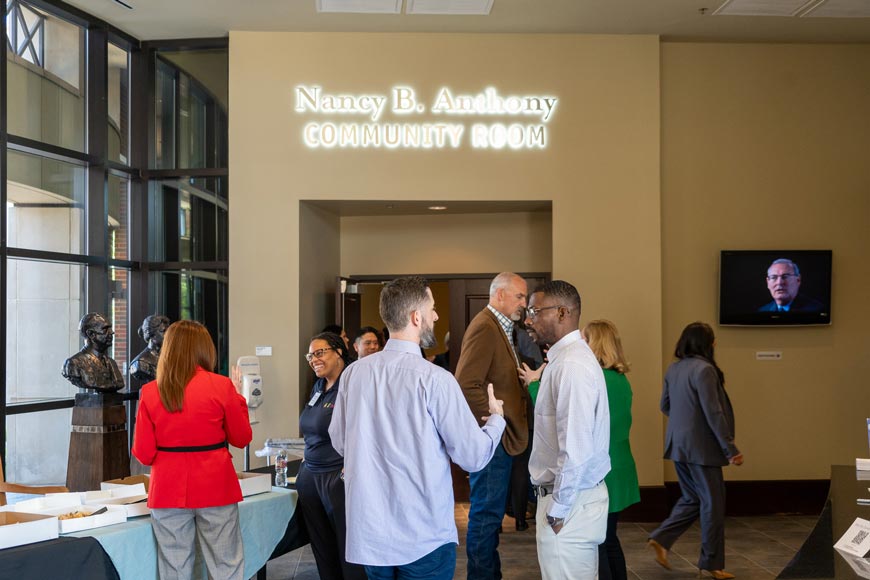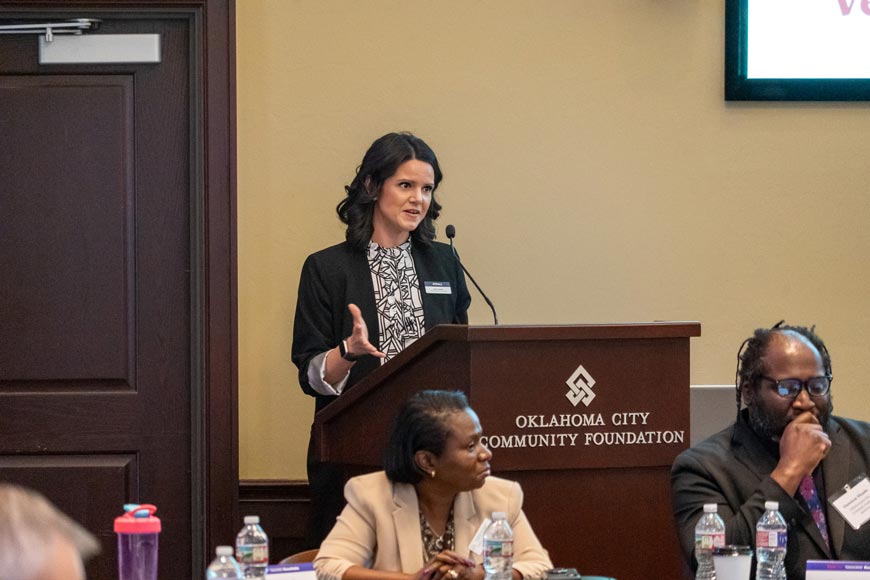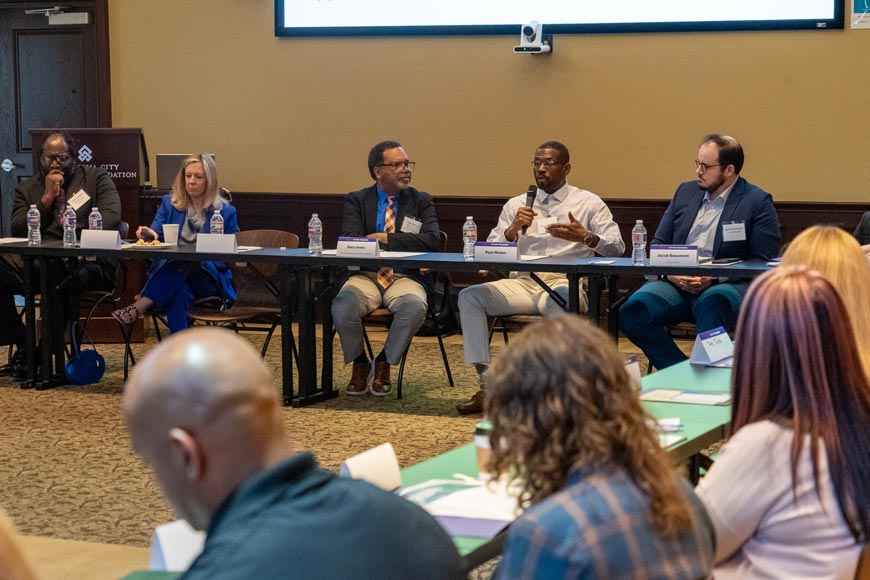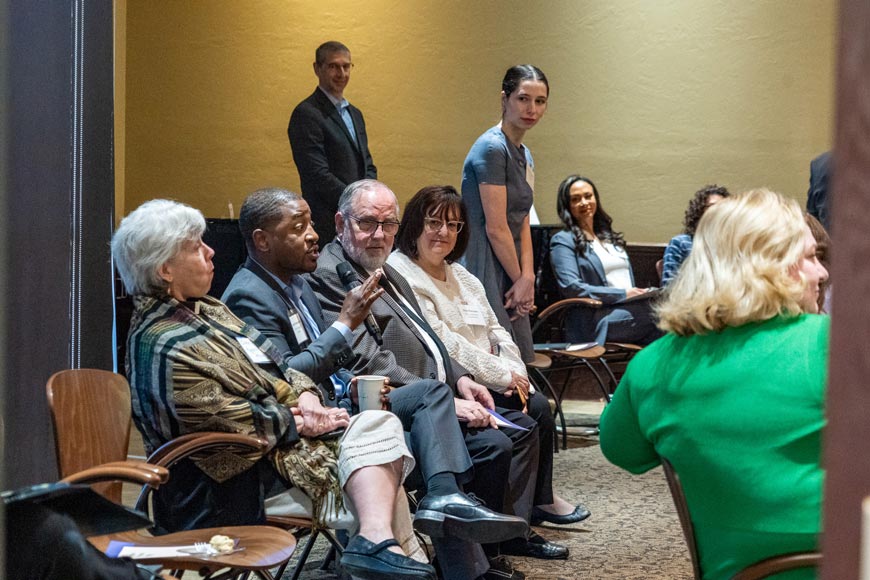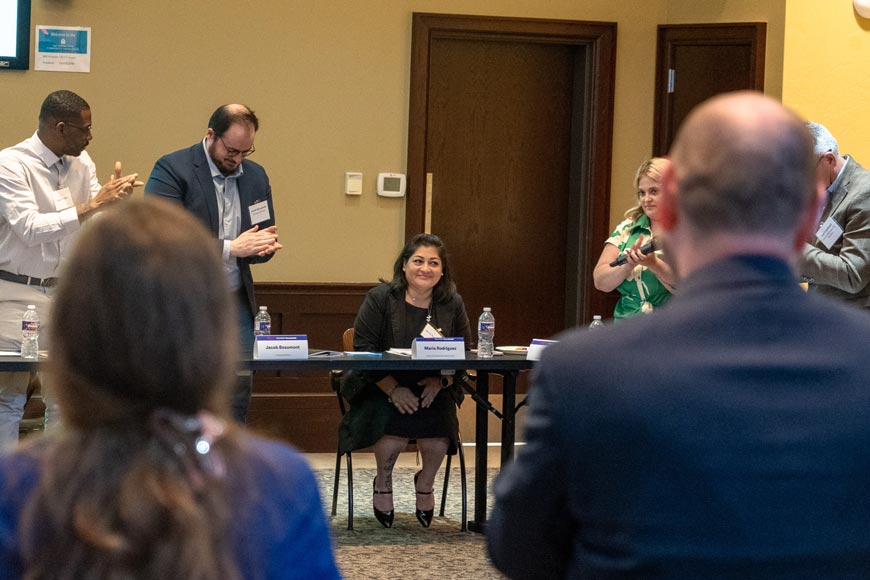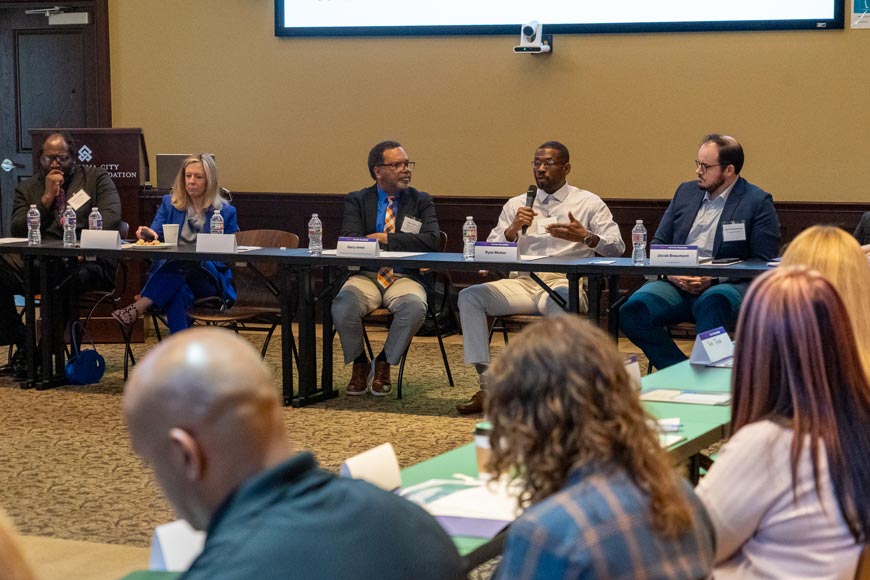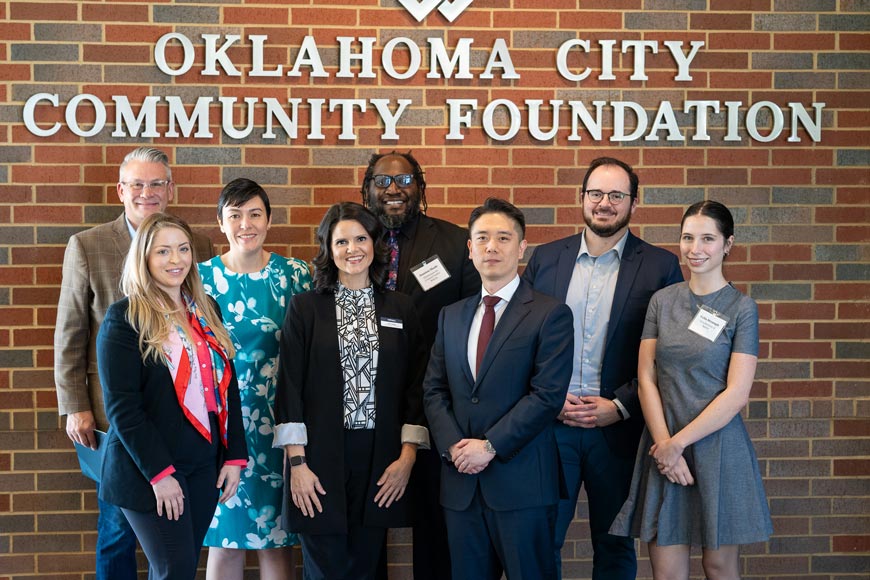OK Economic Mobility and Second Chances Roundtable
On April 12, 2024 — business leaders, nonprofits, and elected officials met to discuss advancing second chance opportunities for justice-involved individuals at the Economic Mobility Roundtable, presented by Arnall Family Foundation, Vera Institute of Justice, and Oklahomans for Criminal Justice Reform (OCJR).
Homelessness, workforce development and justice involvement are complex issues on their own. Numerous challenges arise when they overlap. Many Oklahomans stuck at this intersection of complicated systems and overlapping policies are falling through the cracks, prompting a multifaceted response from multiple sectors.
As part of opening remarks offered by Oklahoma Governor, Kevin Stitt, he mentioned that the state’s high incarceration rates indicate a problem in policy and not in the character of Oklahomans. According to the Governor, since he’s taken office, 4 prisons and 2 private prisons have closed, and 5,000 fewer people are incarcerated.
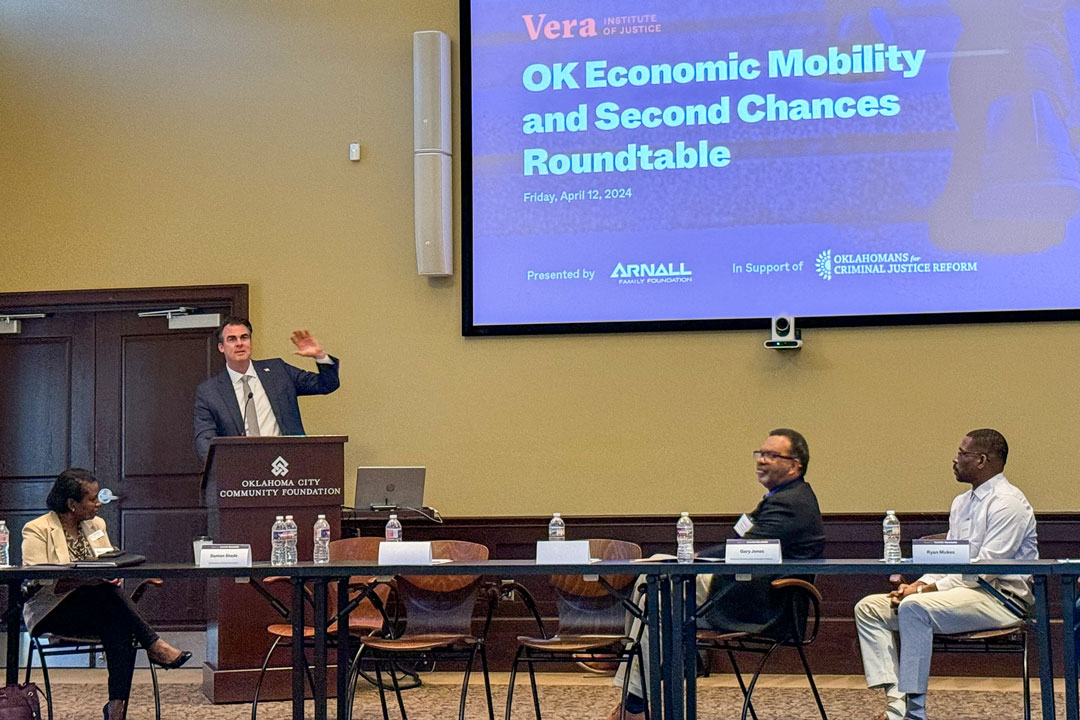
“I believe that we can have safe communities. We can support our law enforcement, while also still believing that people can have a second chance. And that’s why I think we’re all here.”
-Oklahoma Governor Kevin Stitt
Governor Stitt concluded by sharing that since 2019, violent crime is down by almost 12%, nonviolent crime is down 13%, Oklahoma has decreased recidivism by 25%, and all of this was accomplished while decreasing our incarceration rate by 20%.
After Governor Stitt spoke, the roundtable offered a spectrum of voices for the day’s conversations. Each topic was introduced with multiple speakers who offered either their operational expertise or lived experience, followed by questions guided by a facilitator and group discussion.
Topic 1: Housing for Justice-Involved Population
There are plenty of conversations about housing investments and opportunities, but not enough when it comes to housing needs. To illustrate, Gary Jones, government affairs director with Oklahoma City Metropolitan Association for Realtors introduced the idea of a “housing continuum” ranging from no housing on one end to housing investments on the other. The rental housing shortage affects urban and rural areas, forcing low-income families to choose between renting in an area that isn’t ideal for raising a family due to affordability or spending more on housing and less in other areas. Opting between nutritious or low-quality meals and whether to address or ignore medical needs could have serious and lasting implications.
Services working to fill the gaps are overloaded. Jones referenced the growing list of people waiting for programs and services through the Oklahoma Housing Finance Agency, claiming that there’s over 17,000 people (about the seating capacity of Madison Square Garden) in Oklahoma on a waiting list, some as long as 3 years, who don’t have access to a program. Jones believes our policymakers need to better understand why housing is critical for our communities and families, and that policy impacts the everyday lives of people who sit on the lower end of the continuum.

“The need for housing is a key component of how our society even runs today, and where you sit with your housing determines so much about your life.”
-Gary Jones, Oklahoma City Metropolitan Association for Realtors
Ryan Mukes, a justice ambassador at OCJR has experienced incarceration and struggled to gain stable housing for himself and his children after. While speaking about his experience, he acknowledged the relief of having support from OCJR and Diversion Hub after serving and noted that he felt optimistic about the direction the state is headed.
The lack of affordable housing negatively impacts people who are seeking services. With extensive data on the issue, Jacob Beaumont offered some perspective. He is the director of Criminal Justice Initiatives at Housing Solutions, whose mission is to lead in the development, advocacy, and coordination of community strategies to prevent and end homelessness in Tulsa.
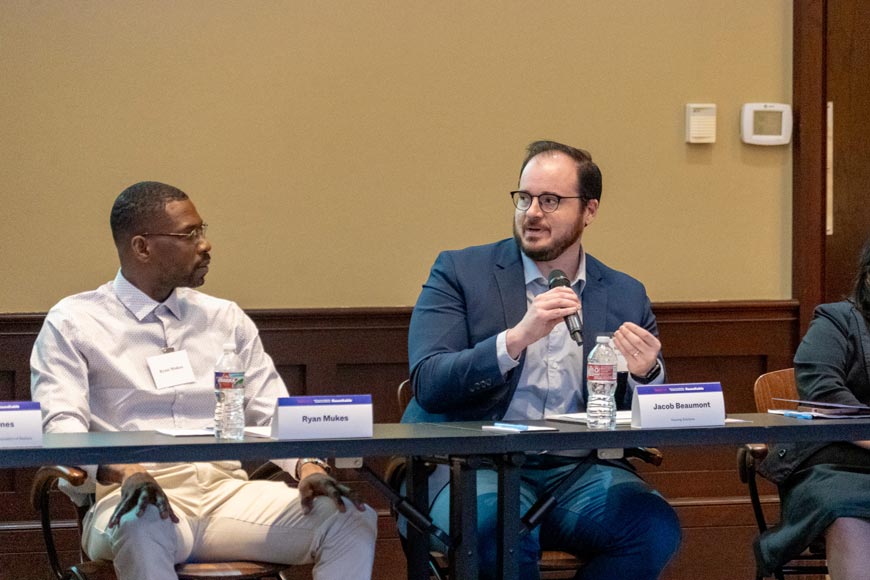
“Tulsa as a community has a housing occupancy rate of 95 to 97 percent,” “So, if we were all to stand up and go to Tulsa and try to find housing, 1 in 20 of us on a good day would actually manage to get our name on a lease. And we don’t have a criminal record holding us back.”
–Jacob Beaumont, Director of Criminal Justice Initiatives at Housing Solutions
Housing Solutions partners with Justice Link to serve individuals facing housing insecurity. According to Beaumont, of the 1,800 people served through the Justice Link program, 606 needed some degree of housing services and 227 were experiencing unsheltered homelessness. Housing Solutions was able to secure housing for 121. Of the 121 individuals housed, only 2 picked up new charges. Beaumont attributed this success to stable housing, adding that only half of the individuals housed needed flexible living assistance. The average cost of flexible living assistance was $700, showing how a relatively small investment can help many reintegrate into society.
TOPIC 1 DISCUSSION HIGHLIGHTS
Q: Where do you see the greatest opportunity to build more affordable housing and to create more access for communities?
Gary Jones, Oklahoma City Metropolitan Association of Realtors
- The housing system is driven by profit-motivated developers, resulting in a lack of affordable housing.
- Current policies do not incentivize or support development of affordable housing to meet the needs of individuals at lower price points.
“We have this little, what we call, ‘magic number’ in the real estate business that if you’re not building a house that’s $250,000 or more, you’re gonna struggle to make some money off of it,” said Jones. “For most Oklahomans, qualifying for a $250,000 mortgage is impossible.”
Camal Pennington, Executive Director of It’s My Community Initiative and Chair of the Oklahoma City Planning Commission
- Part of the challenge with housing is the very public process for building it.
- Increasing density would make housing more affordable
- The law in Oklahoma City requires that we use 6,000 square feet (about the area of a basketball court) of land for each single-family home.
-
Oklahoma City is trying to address the barriers to increasing density through a zoning code update, which would include being able to build duplexes on single-family lots and allowing accessory dwelling units.
- Neighborhoods, like Lincoln Terrace, that include quadplexes, duplexes and apartments all within the same neighborhood, which provides for a diverse community, but there are challenges to introducing these concepts elsewhere in Oklahoma City due to the fear that it will reduce property value and increase crime.
- Increasing density does not increase crime or decrease property values.
- We need to have a more robust public conversation about these options.
Q: What are two common housing related challenges for the criminal justice population that must be addressed today?
Ryan Mukes, OCJR
- There is not enough investment in existing houses that are vacant.
- If incentives existed or policies changed to make renovating vacant properties more affordable, it could help.
- Making housing more affordable would make it easier for justice-involved individuals, single parents, and low-income families to get loans. Most justice-involved individuals are “pigeonholed” into a position with no opportunity to eventually make more money.
“If you drive through Spencer, you drive through Midwest City, you’ll see a lot of vacant houses, and it just blows my mind. I remember being a kid and wishing I could live in that house, and now when I drive by it’s going to ruin.”
Jacob Beaumont, Housing Solutions
- The two biggest challenges in relation to housing are mental illness and lack of income.
- 63% of Housing Solutions clients are dealing with severe mental illness and 73% of mental health court participants in Tulsa are experiencing homelessness, while also trying to pay mental health court obligation.
- 80% of Housing Solutions clients have $0 in income, 14% rely on $1,000 or less annually, and the remaining 6% rely solely on social security and disability.
- Pushback on Housing First models fails to see how having a home provides the necessary foundation to find success in every other aspect of a person’s life. Having housing helps people secure employment, be successful in rehabilitation and prevents recidivism.
- The more we build support around providing jobs to acquire income, the more success we will see with justice-involved individuals who are homeless.
Joe McNeel, Our Blood Institute (formerly known as Oklahoma Blood Institute)
- Employers need more awareness of programs and resources that can help employees who need them.
- OBI hires 30 employees every month, working with ReMerge and Diversion Hub to provide second chance employment opportunities. A few of these individuals typically are experiencing housing insecurity
- OBI has an employee-sponsored benevolence fund dedicated to helping employees pay fees, buy housing supplies or to get them into an apartment.
Lee Copeland, Greater Oklahoma City Chamber
- Address root causes of housing issues by looking at the system that creates them.
- Employers need to see housing, housing intervention, and housing assistance as a potential strategy from the perspective of talent retention.
“First, at a city level, I think a more pointed discussion about what is the definition of true housing affordability, and then how do we incentivize the development or the maintaining of truly affordable housing.”
Jim Frees, Goodwill Industries of Central Oklahoma
- A job is important in retaining housing, but wraparound services are needed especially for vulnerable populations.
- WorkLife Partnership is a nonprofit that Goodwill Industries uses to help provide additional services.
Gary Jones, Oklahoma City Metropolitan Association of Realtors
- Policymakers know there is a problem, but only know what individual lobbyists or entities inform them about. They are not seeing the big picture.
- Other states have held housing conferences to address housing needs.
- We have not addressed growth in Oklahoma. The state is becoming like places we criticized for not having affordable housing.
Topic 2: Employment for Justice-Involved Population
Oklahoma City has no shortage of organizations advocating for individuals on the front end, but the systemic change that employers can create is often overlooked. 35% of Oklahoma’s population is eligible to participate in the labor market but isn’t employed, according to Lee Copeland, the director of Talent Initiatives at the Greater Oklahoma City Chamber. This includes those with disabilities, veterans, those who have left the labor force due to elder and childcare, and people with prior justice involvement.
Copeland believes we need to stop telling people to apply for jobs simply because positions are open without understanding the potential barriers on the employer side to hiring justice-involved workers. Blindly sending someone into a losing situation can dampen their drive to persevere. According to Copeland, bridging the gap between nonprofits and employers will help employers understand their power to make a difference and open the door to employment for safe, reliable, and driven workers in a more positive way.
Emily Ray is the site director for Center for Employment Opportunity (CEO), a nonprofit that provides comprehensive employment reentry services to Oklahomans experiencing barriers to employment. Between their offices in Oklahoma City and Tulsa, CEO served nearly 5,600 Oklahomans exiting incarceration.
Surveys of formally incarcerated individuals indicate that employment was the single most important factor in decreasing recidivism. Data indicates that justice-involved Oklahomans have an unemployment rate about five times higher than the national average. Having a criminal record alone reduces the chances for a second interview by 50%. Misconceptions surrounding tenure, performance, conduct, and safety continue to impact those with a criminal record, despite extensive research.
Maria Rodriguez is a current participant at CEO who shared her experience. Formerly a phlebotomist, she was forced into a difficult situation trying to take care of her children after a divorce. One desperate decision landed her in prison where she served 7 years for transporting drugs across the U.S. border.
Rodriguez described trying to secure stable housing and employment with her criminal record as a nightmare. As a naturalized citizen, with no family in the U.S. and an expired ID from Texas — her situation is complicated, but not rare for many justice-involved people who experience challenges of being without a valid state ID after reentry. Rodriguez was eventually able to find housing with few requirements, but now she worries every day that her landlord will ask for an updated ID or become aware of her background.
Finding stable employment has been even more difficult due to similar issues. She is technically employed by CEO, using a Consolidated Record Card (CRC), which is a government issued state ID, but has been unable to find an employer who will accept it as a secondary document for I-9 paperwork. “Proper Identification and employment are your keys to everything,” Rodriguez said. “And you can’t do one without the other.” She hopes to one day own a car, have her own apartment, and go back to school.
TOPIC 1 DISCUSSION HIGHLIGHTS
Q: What are the key barriers for employers to provide more sustainable solutions to challenges with second chance employment, hiring, and retention?
Tony Tyler, Tyler Media
- Employers need assurances and vetting from organizations for justice-involved workers to make hiring decisions.
- Hiring people with felonies doesn’t always work out, either because they aren’t right for the job or because employers don’t provide the right support for them.
Joseph Brantley, MD Building Products
- Employers should build partnerships with community organizations, like CEO, so that the organizations can become familiar with hiring criteria and more effective at suggesting potential candidates.
Lee Copeland, Greater Oklahoma City Chamber
- A centralized network where employers can post their positions for second chance hires and provide details on pre-employment requirements such as credit and background checks would help streamline hiring.
- Working together, speaking with one voice to employers will ensure that they have a single point of contact.
Margaret diZerega, Vera Institute of Justice
- In Michigan, the Department of Corrections has “vocational villages” which is a skilled trades program for inmates.
- Employers come in and can see the quality of training they are receiving and can suggest types of training to offer that align with workforce gaps in Michigan.
- Once a position is available, employers and DOC communicate to make employers aware that an inmate is coming home to their county and to offer resumes. People are getting interviewed and hired pre-release
- Some states have certificates of rehabilitation that can be ordered through the court.
Bryan Boaz, Dolese Brothers
- A reentry class at Moore-Norman Technology Center trains professionals to help recently released prisoners become successful citizens. Learning about the barriers people face as they come out of incarceration, even for low-level offenses, is eye-opening
- Understanding the realities of working alongside individuals with prior justice involvement can help encourage businesses, like Dolese, to become second chance employers.
Photos From the Roundtable
“It feels like we’ve started the beginning of a conversation here that I hope will not stop today. Let’s commit ourselves to solutions, a solutions-oriented agenda.”
-Damion Shade, OCJR
After the roundtable, and in an ideal turn of events — Maria Rodriguez was hired at OBI as a mobile phlebotomist and started in May, making this a full circle moment and emphasizing the wonderful things that can happen when research, compassion and cross-sector collaboration come together.

